Jaipur adds a dash of pink to the colorful state of Rajasthan. Popularly known as the ‘Pink City of India’, this exotic destination is ideal for a luxe trip. Brimming with hospitality and luxuriance, Jaipur is the perfect spot for indulgence for tourists from across the world. The eclectic mix of traditional and modern attractions keep travelers with varying interests entertained for days.
The welcoming and vibrant Pink city is an ideal place for exploring Rajasthani culture and heritage. As you walk through the lanes of the city, you experience the opulent lives of the Rajputana kings through the splendid forts, palaces and Havelis splattered all across. You can also visit the museums and memorials of prominent kings of the land to step into their shoes and experience royalty.
Beyond exploring the top places to visit in Jaipur such as the magnificent Amber Fort, Hawa Mahal, Jaigarh Fort, and Hawa Mahal, you can indulge in delicious Rajasthani cuisine and shop at its sprightly bazaars. The markets at Johari Bazar, Bapu Bazar, and MI Road are laden with embroidered leather shoes, embellished handicrafts, regal blue pottery, brilliant tie and dye scarves, camel hide products, and jazzy handmade apparels. You can also witness the beauty of the Thar desert on an exciting camel safari or immerse in the kaleidoscopic Rajasthani culture celebrating local festivals like Dhulandi, Teej, and Gangaur.
Top Places to Visit in Jaipur
Jaipur allures those planning a grand holiday and a rejuvenating trip while diving deep into Indian culture and heritage. The top places to visit in Jaipur are:
1. Amber Fort
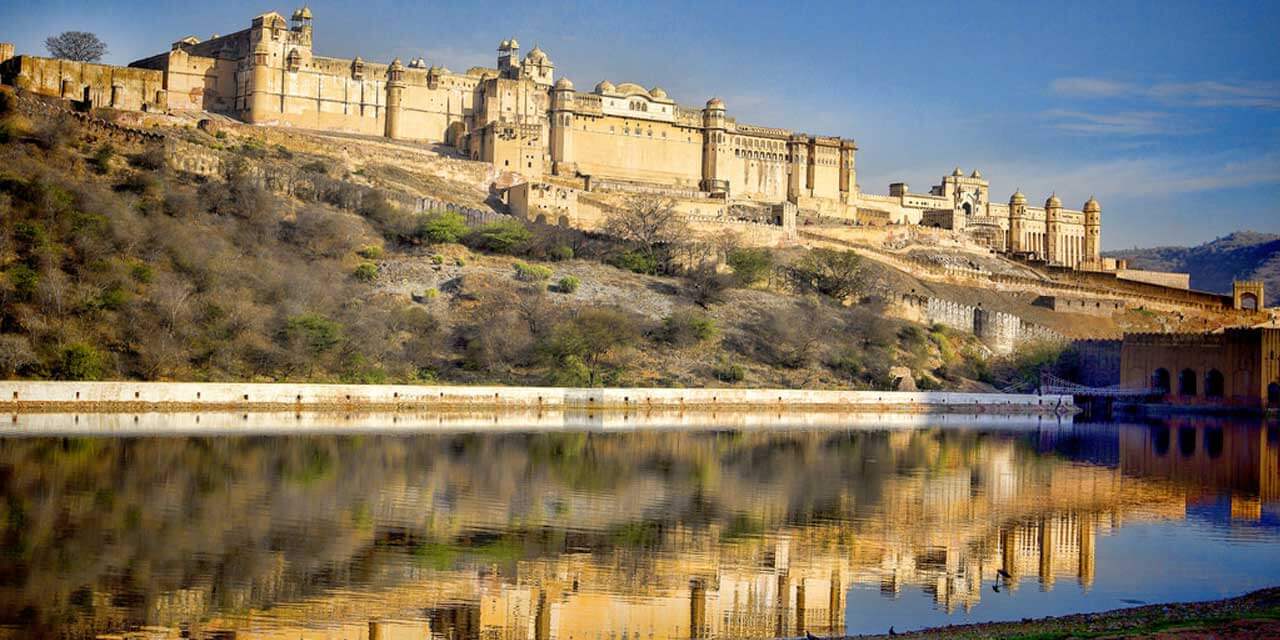
The legendary Amber Fort is a seven centuries old Rajputana palace located around 11 kilometers away from Jaipur. Recognized as a UNESCO World Heritage Site, it is among the most magnificent architectural wonders of India.
Set up on the Aravalli hills, the Amber fort (also known as Amer Fort) was constructed by Raja Man Singh I in 1592 and was completed by Mirja Raja Jai Singh. Built in red and yellow sandstone complemented by white marble, the splendid fortress offers a breathtaking view of the Maota Lake.
The splendid palace is divided into four courtyards and includes attractions such as Diwan-e-Aam, Diwan-e-Khas, Siladevi Temple, and the Sheesh Mahal. The main entrances to the palace are Suraj Pol and Chand Pol, both of which lead to the main courtyard called Jaleb Chowk. You can enjoy an elephant ride to the fort entrance or take a car. After spending three to four hours exploring the fort you can dive into its history with the beautiful light and sound show.
- Timings: 7:00 AM – 9:00 PM
- Entry Fee: ₹100 (Indians), ₹500 (Foreigners)
2. Jaigarh Fort
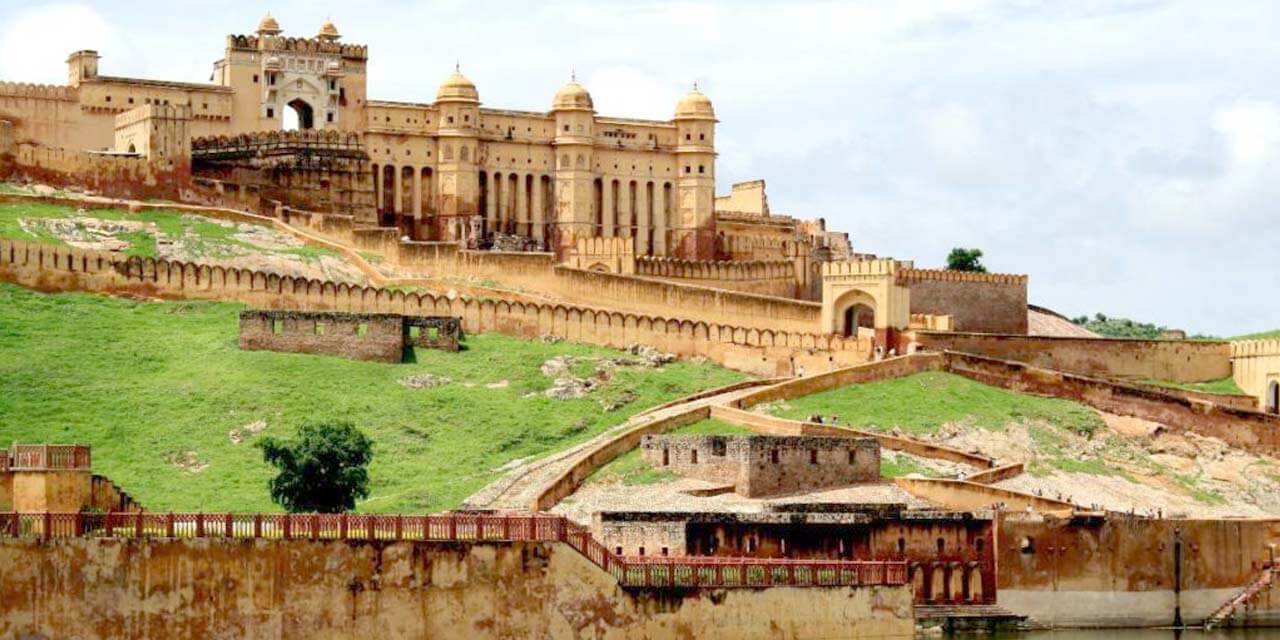
Built on ‘Cheel ka Teela’ or the Hill of Eagles, Jaigarh fort was built to secure the Amber Fort. Located 500 feet above sea level, the fort offers panoramic views of the Amber Fort and its lush surroundings.
Constructed in 1726 under the aegis of Maharaja Sawai Man Singh II, the fort has a splendid blend of Indo-Persian architecture. Intricate lattice work windows adorn the cyclopean walls of the fort to offer unobstructed views of the vicinity. You can walk through the magnificent red sandstone fort and imagine life in the era of the warrior kings that inhabited it ages ago.
One of the major attractions at the fort is 'Jaivana Cannon' which is the world’s largest cannon on wheels and has been fired just once since it’s existence. Other attractions include the central watchtower, the water heritage walk, Shubhat Niwas (the assembly hall of warriors), and armory. The complex also houses several prominent temples such as Kal Bhairav Temple, Ram Harihar Temple, Lalit Mandir, Aram Mandir, and Vilas Mandir.
- Timings: 9:00 AM – 6:30 PM
- Entry Fee: Starting from ₹75 (Indians), ₹100 (Foreigners)
3. Nahargarh Fort
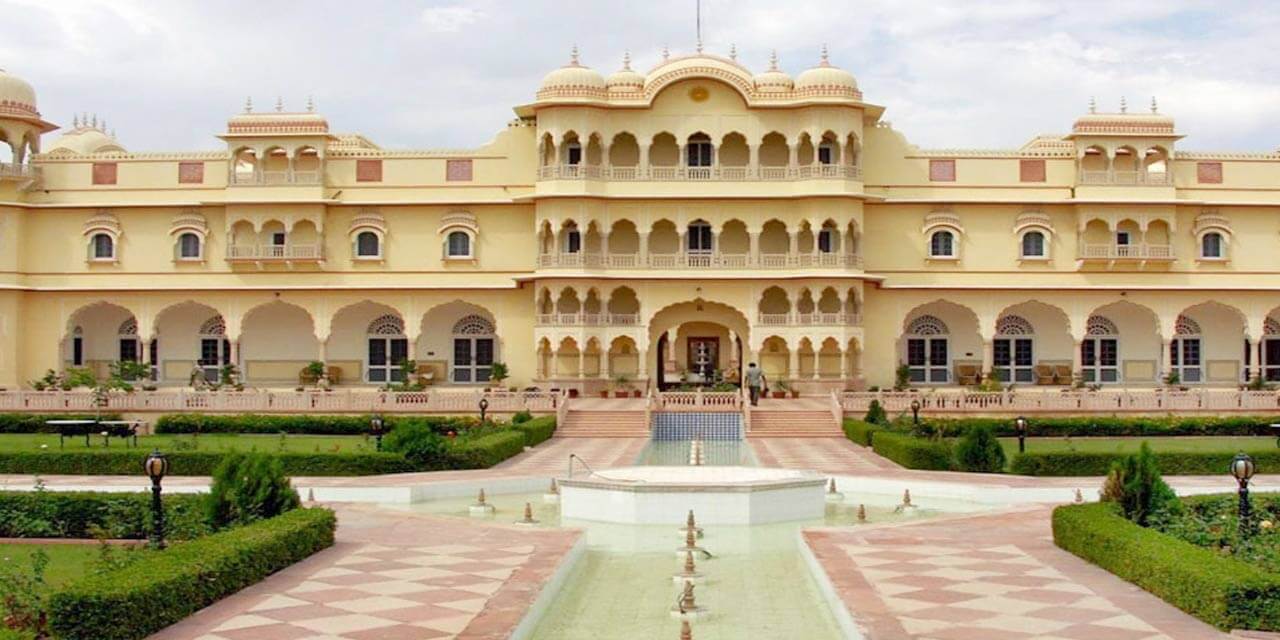
Nahargarh Fort was built amidst the Aravalli Hills to fortify the royal residence of the Rajput warriors, the Amber Palace. This majestic structure has overlooked the beautiful city of Jaipur for 300 years. It was constructed by Maharaja Sawai Jai Singh II in 1734 as a retreat palace for the kings and queens. It’s fascinating Indo-European architecture and glorious past has attracted tourists from across the world.
The Fort has witnessed important historical events during the 18th Century. You delve deeper into history as you visit the temple dedicated to the Kings of Jaipur and also explore the astounding Sheesh Mahal, visit the wax museum, and click pictures near Jal Mahal.
Other not-to-be-missed attractions are 'Madhavendra Bhawan' built by Sawai Madho Singh and the temple of Rathore prince Nahar Singh Bhomia, whose spirit haunted the construction site until the fort was dedicated to him.
- Timings: 10:00 AM – 10:00 PM
- Entry Fee: ₹50 (Indians), ₹200 (Foreigners)
4. Jantar Mantar
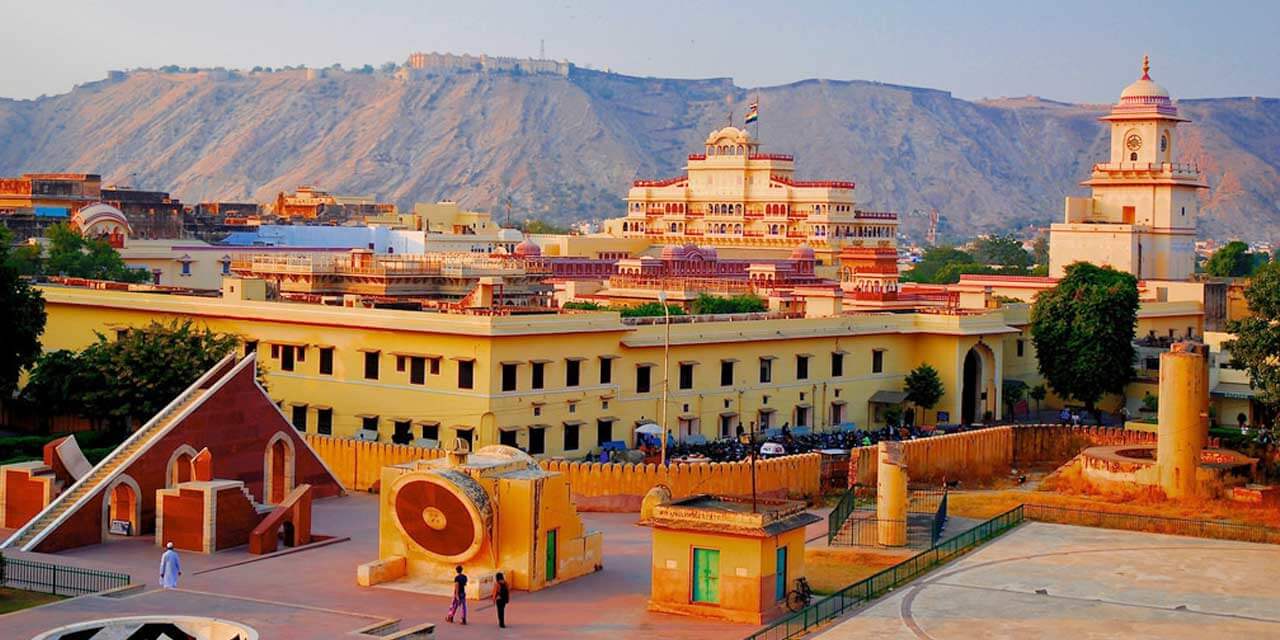
Located in the heart of Jaipur, Jantar Mantar is an astronomical observatory built by Maharaja Sawai Jai Singh II between 1728-1734. The observatory had been a meeting point for scientific cultures from across the world and linked political, social, and religious practices to cosmology.
Recognized as a UNESCO World Heritage site it is the largest among the other five similar ones built in Northern India. It houses large stone instruments with striking combinations of geometric forms to view celestial bodies through naked eyes. The precision and accuracy of these astronomical instruments have been alluring architects, mathematicians, artists, and historians since times immemorial.
The observatory also features the world’s largest stone sundial which calculates local time and manages to entice the interest of tourists to date. To understand the process of determining planetary movements through observation and calculations you must visit Jantar Mantar at noon, as the readings of the instruments are accurate when the sun is overhead.
- Timings: 9:00 AM – 7:00 PM
- Entry Fee: ₹50 (Indians), ₹200 (Foreigners)
5. City Palace
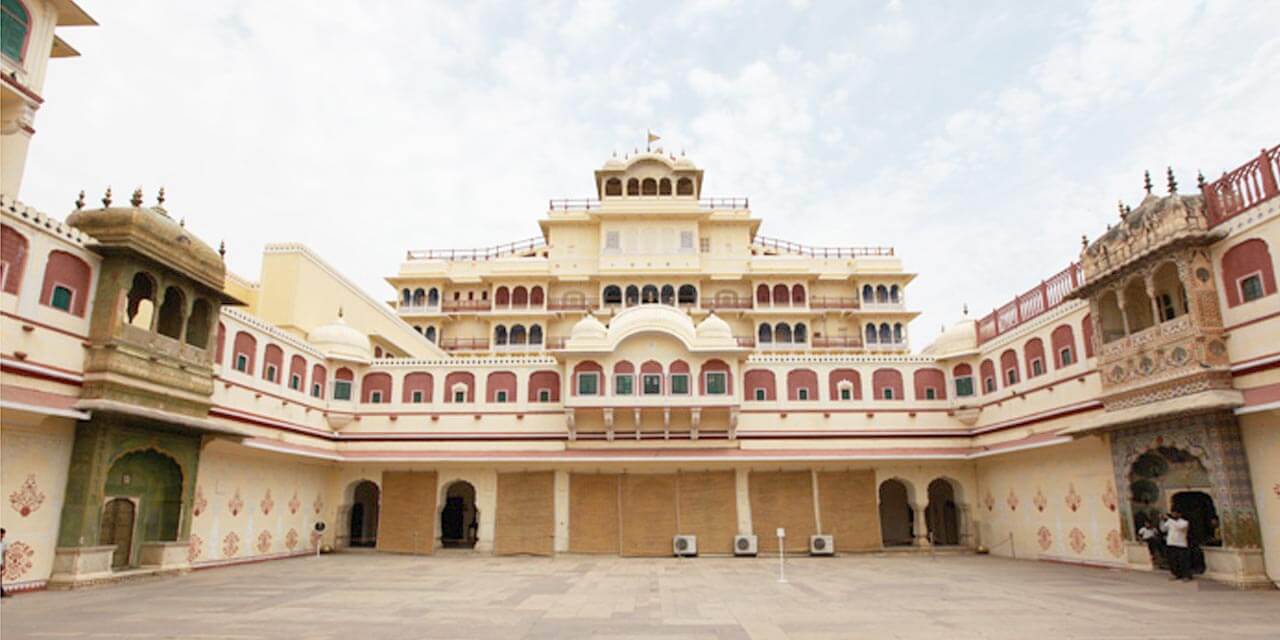
Located in the heart of the old city, the City Palace, comprises magnificent courtyards, gardens, cenotaphs, and royal buildings. It was conceived and built by the founder of Jaipur, the Rajput King Maharaja Sawai Jai Singh II, and expanded by the rulers who inhabited it later.
The palace has elements of Rajput, Mughal, and European architecture intricately put together to exude opulence. Members of the last ruling royal family still reside in a private section of the palace. The most prominent sections of the palace are Mubarak Mahal, Chandra Mahal, Maharani’s Palace, Maharaja Sawai Man Singh II Museum, and Bhaggi Khana.
You can witness the unique collection of royal costumes including Pashmina shawls, Benaras silk sarees, and other clothes of Maharaja Sawai Madho Singh I at the museum. Rajput weaponry dating back to the 15th century and well preserved Rajputana paintings, Sanganeri prints, and folk embroidery pieces adorn the walls and ceilings of the palace.
- Timings: 9:30 AM – 6:30 PM (Day Visit), 7:00 PM – 7:30 PM (Night Visit)
- Entry Fee: Free
6. Hawa Mahal
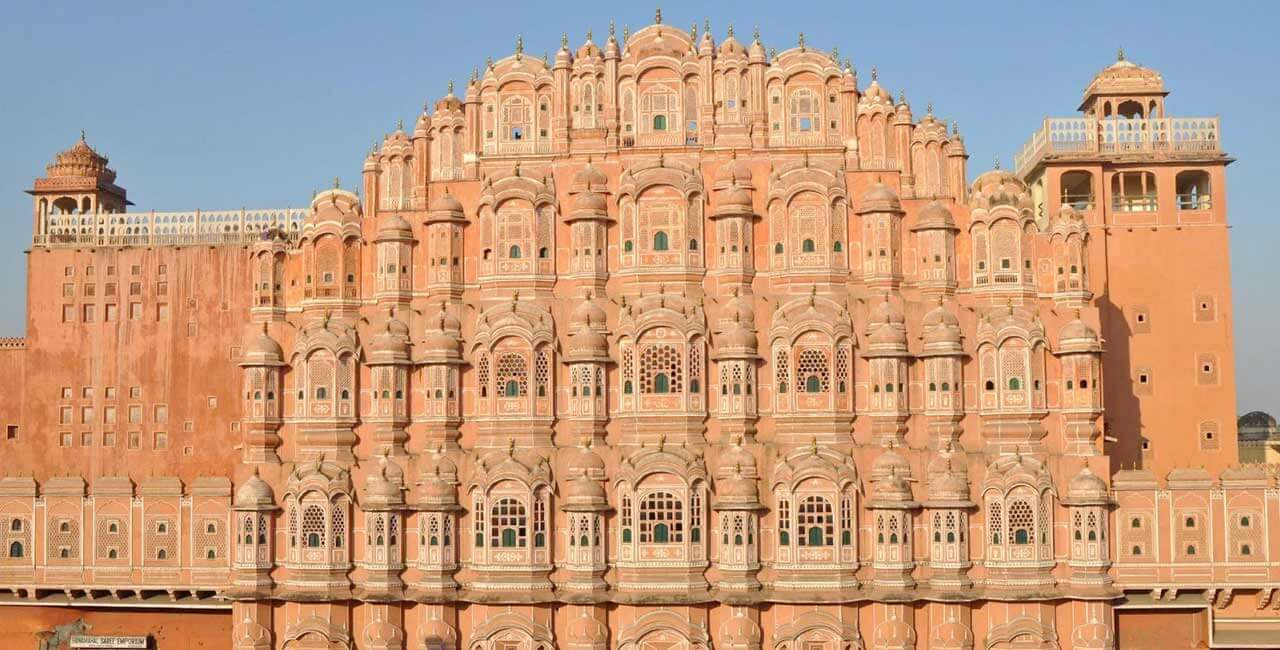
The most iconic landmark of Jaipur, Hawa Mahal is a 200-year-old monument in the heart of the city. Famous for its unique honeycomb design and Indo-Islamic architecture the five-storeyed palace has 953 lattice work windows. It was built in 1799 by Maharaja Sawai Pratap Singh as a summer palace, painted in pink and adorned with floral motifs, dome-shaped arches, and patterned pillars.
The palace was designed to offer unobstructed views of Jantar Mantar, the City Palace, and Sireh Deori Bazaar. Its intricately designed windows called ‘Jharokhas’ enabled the royal ladies to enjoy royal processions and daily market activities on the street without being visible to the public.
Royal celebrations took place on the first floor called the Sharad Mandir, the second floor called the Ratan Mandir was decorated with colorful glass work, the other two floors were named Vichitra Mandir and Hawa Mandir. The top floor known as Prakash Mandir had an open terrace on each side offering breathtaking views of the city. You can visualize their lives looking through the fretwork windows and experience the richness of Rajputana culture through the paintings and ceremonial armor preserved at the museum within the complex.
- Timings: 9:00 AM – 7:00 PM
- Entry Fee: ₹20 (Indians), ₹200 (Foreigners)
7. Laxmi Narayan Temple/ Birla Mandir
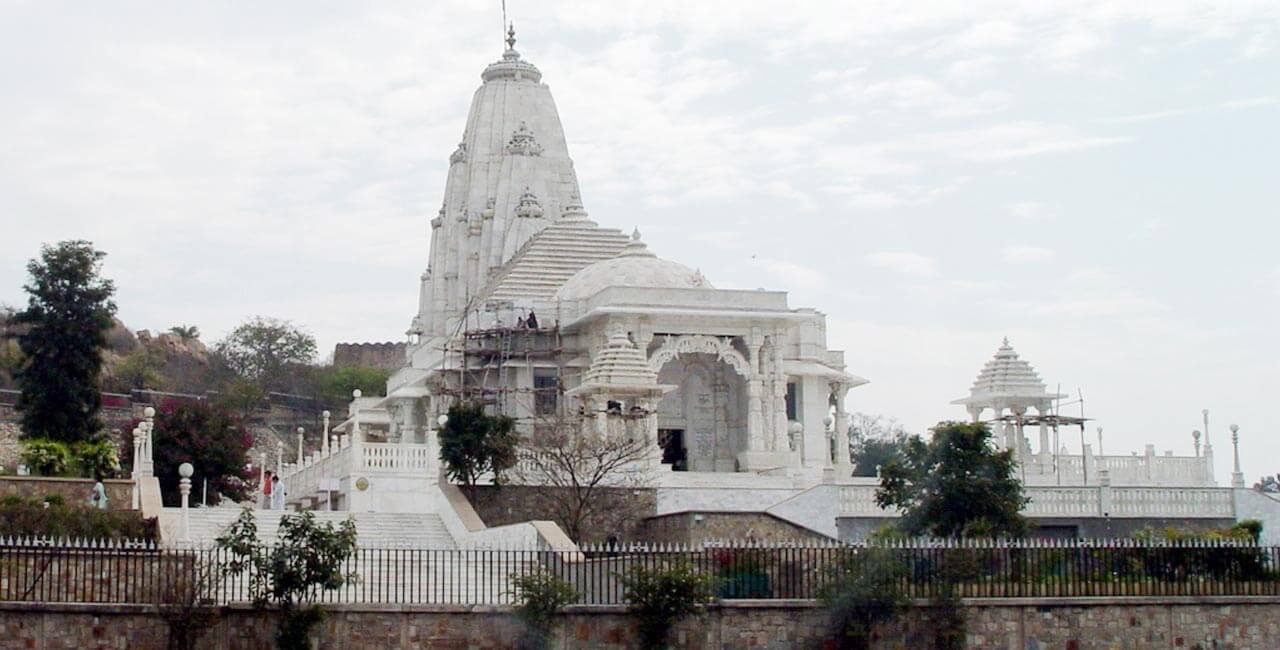
Located at the foothill of Moti Doongri, the Laxmi Narayan Temple or the Birla Mandir was built in 1988 by the B.M Birla Foundation. Land for the temple was given by the Maharaja of Jaipur for a token amount of one rupee. Birla Mandir is renowned for its architectural excellence crafted in pure white marble.
Dedicated to Laxmi (the goddess of wealth) and Narayan (Lord Vishnu), the temple houses hand-sculpted idols of the deities, carved out of single piece marble. Like the other Birla temples across the country, the Laxmi Narayan temple signifies the diversity and richness of Indian culture and the holistic approach of Hinduism.
Its three-dome design is a representation of secularism among different religions in India. Intricate designs and mythology-based carvings adorn the domes, ceilings, and walls of the temple. The presence of statues of great philosophers and religious teachers from across the world represent the inclusiveness of modern Indian culture.
The lush green gardens complement the architectural finesse of the temple and add serenity to the spiritual atmosphere. Tourists of diverse religious beliefs flock to the temple to view its mesmerizing beauty.
- Timings: 8:00 AM – 12:00 PM, 4:00 PM – 9:00 PM
- Entry Fee: Free
8. Moti Doongri Ganesh Temple

Moti Doongri Ganesh Temple is among the most revered temples of Lord Ganesh in Jaipur. It was built by Seth Jai Ram Paliwal and Mahant Shiv Narain in 1761.
Locals associate it with the legend of the King of Mewar who was heading back to his palace with a massive idol of Lord Ganesh on a bullock cart. As per the story, the king decided to build a temple at the first stoppage of the bullock cart. Locals believe that the foot of Moti Doongri Hill was the spot where the bullock cart stopped and the temple was constructed on the site.
An exotic palace was built for Maharaja Madho Singh’s son at the site encompassing the temple. The palace has exteriors similar to those of a Scottish castle and was the royal residence of Maharaja Sawai Man Singh. You can seek blessings at the Ganesh Temple and wow at the exteriors of the palace as it continues to be occupied by the royal family.
- Timings: 5:30 AM – 1:30 PM, 4:30 PM – 9:00 PM
- Entry Fee: Free
9. Govind Dev Ji Temple
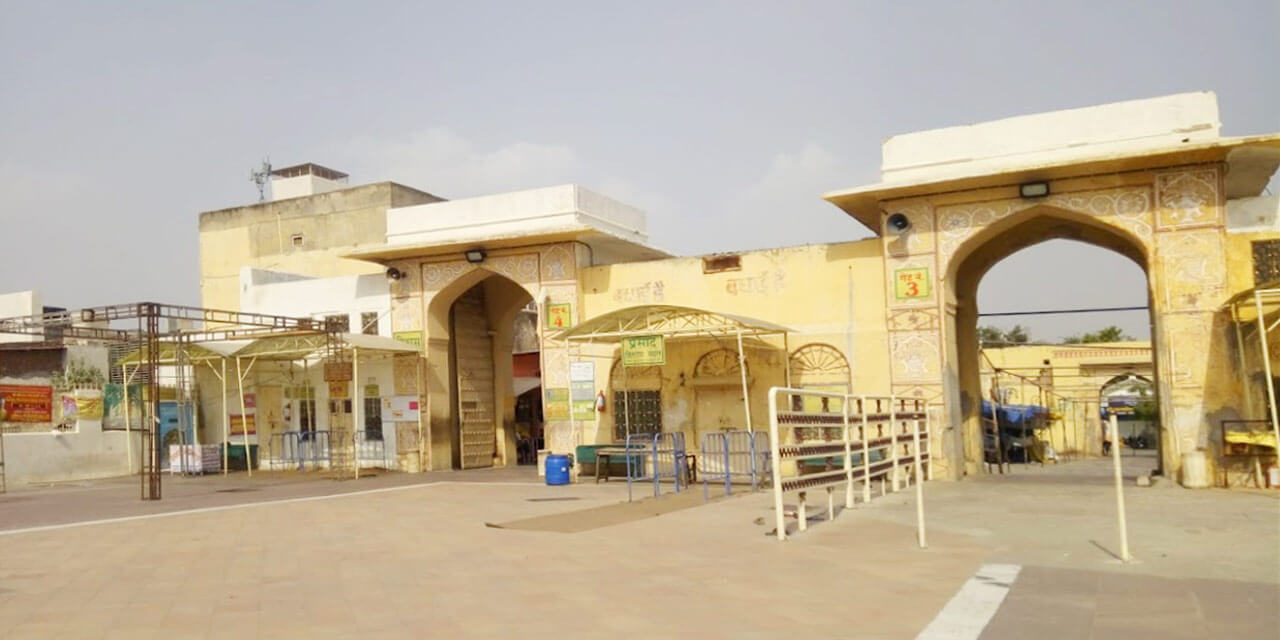
Govind Dev Ji Temple in Jaipur is among the seven revered temples of Vrindavan Thakur Ji. It is located in the City Palace complex and is famous among devotees of Lord Krishna. The temple is exquisitely designed with gold cased ceilings and intricately designed exteriors.
The temple houses the idol of Govind Dev Ji, known as ‘Bajrakrit’. It is believed to resemble Lord Krishna and was sculpted by his great-grandson Bajranabh. The 5000 years old idol was brought to Jaipur from Vrindavan by Raja Sawai Jai Singh, who was a devotee of Lord Krishna.
The temple was strategically placed between Chandra Mahal and Badal Mahal in the complex to ensure the devout king could view the idol from his residence. To date 'Aartis' and 'Prasad' or 'Bhogs' are offered at seven different times during the day. You can plan your visit to the temple around Janmashtami to enjoy the celebrations during the festival.
- Timings: 4:15 AM – 12:00 PM, 4:00 PM – 8:30 PM
- Entry Fee: Free
10. Ram Niwas Garden
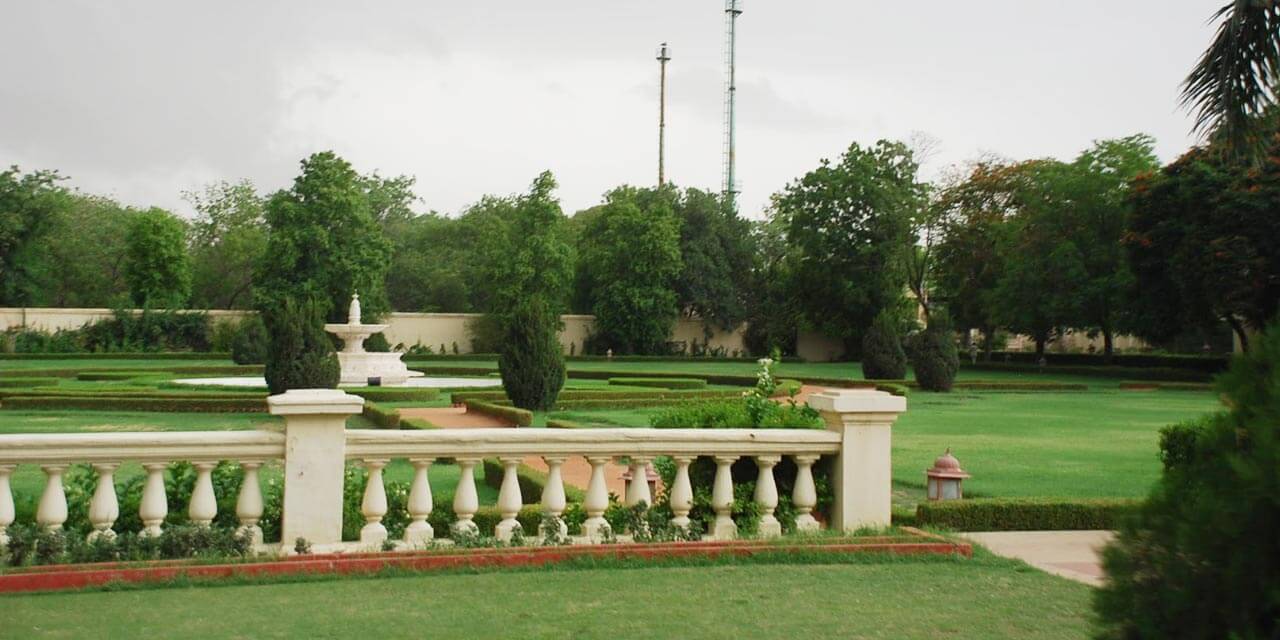
Located in the heart of the pink city, Ram Niwas Garden is a royal garden. It was built in 1868 by Maharaja Sawai Ram Singh. Sprawling over 30 acres of land it attracts tourists from all over the world. The lush green garden is decorated with fountains and has a regal ambiance. It has been flocked by locals and tourists alike since the British Era.
Visitors can also attend the exhibitions held in the park or go bird watching. The park also features a Zoo, a theatre, and an Art Gallery luring a wide variety of travelers. You can relax at the park after a hectic shopping day at Bapu Bazaar which is just next to the park or just rejuvenate enjoying a family picnic outing. Besides the serene atmosphere, there are Quaint cafes around the park that serve delectable Rajasthani snacks.
- Timings: 5:30 AM – 5:30 PM (Summer), 9:00 AM – 5:00 PM (Winter)
- Entry Fee: ₹20 (Indians), ₹100 (Foreigners)
11. Chokhi Dhani
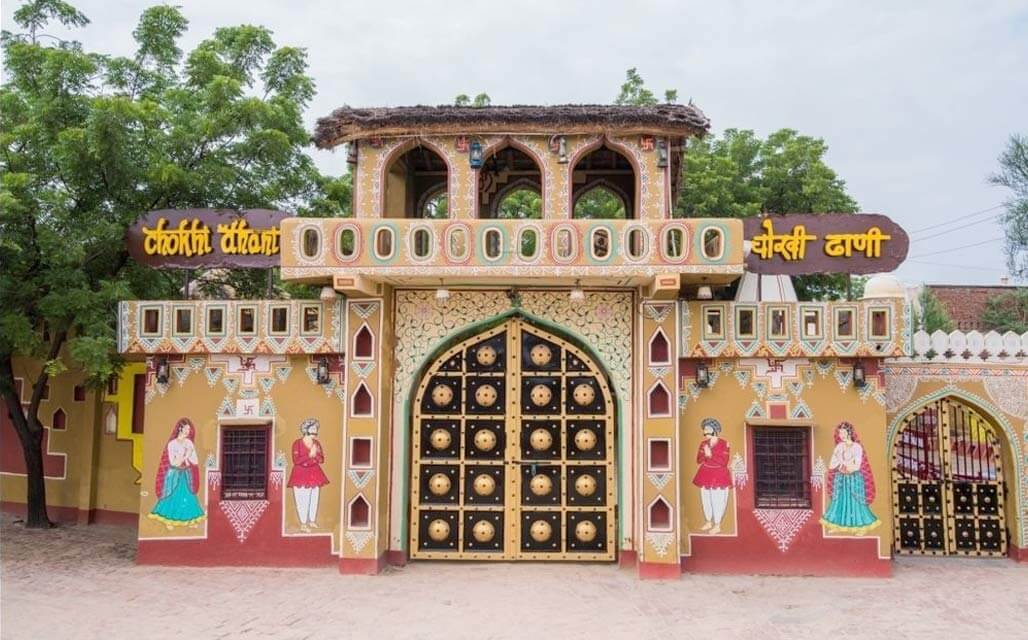
Chokhi Dhani is a Rajasthani theme-based resort located 28 kilometers away from the city. It was established in 1989 to offer a glimpse of rustic village life and authentic Rajasthani lifestyle to tourists. The resort has a traditional vibe- featuring mud huts decorated with ethnic motifs, Rajasthani folk performers singing and dancing to entertain the visitors, and authentic Rajasthani food.
Evenings at the resort are busy and fun. You can enjoy activities such as live folk dance and music (Chaupal Nach Gan Re), acrobatics (Nat Ro Kartab), puppet shows (Kathputali Ro Nach), and magic shows (Jadu Ro Khel). You can shop for local handicrafts at the craft bazaar and take leisurely rides on camels, horses, and elephants.
Chokhi Dhani has been accredited as a 5-star luxury hotel by the Ministry of Tourism. For those looking forward to indulging in the royal culture of Rajasthan, the resort has Royal Cottages and Haveli Suites flaunting their regal décor comprising historical relics, vintage furnishings, and handmade artifacts.
- Timings: 5:30 PM – 10:30 PM
- Entry Fee: ₹1000 (Adult), ₹600 (Child)
12. Jal Mahal
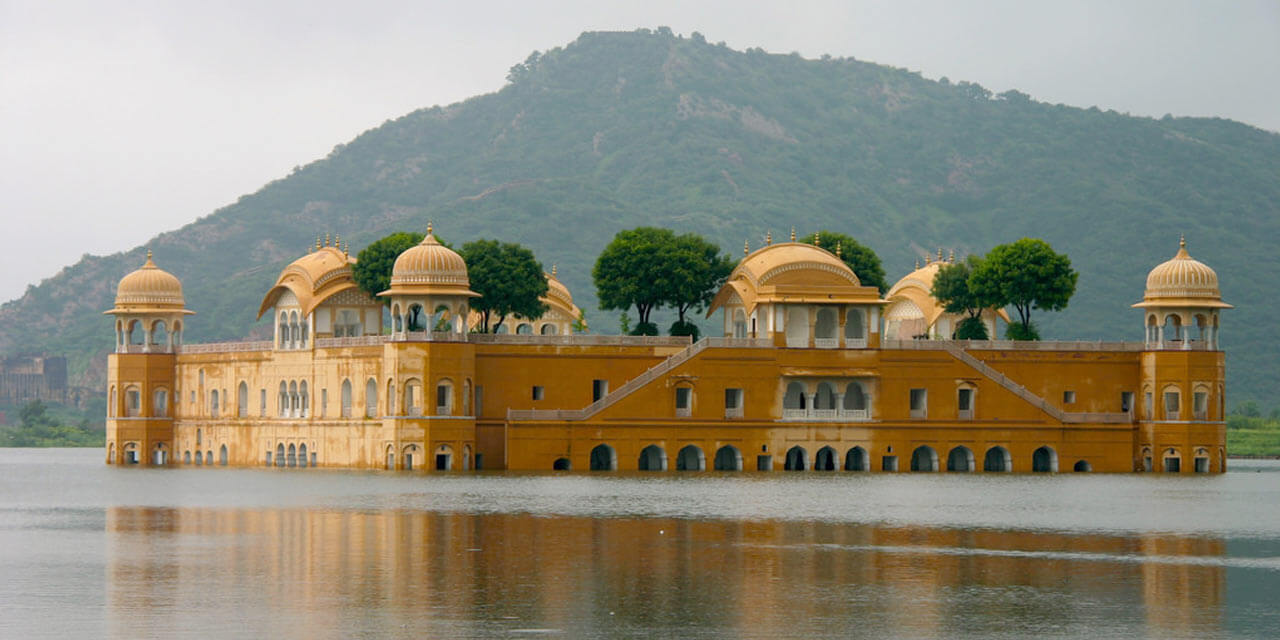
Located 4 kilometer away from Jaipur, Jal Mahal is one of the most popular landmarks of the city. It was built in 1750 by Maharaja Madho Singh as a lodge and hunting retreat. The symmetrical five-story structure of the palace is set in the middle of an artificial lake known as Man Sagar Lake.
The mesmerizing view of the beautiful palace against the backdrop of Aravalli hills and its reflection in the serene lake waters lures thousands of tourists from across the world. Jal Mahal is also recognized as the most photographed structure of India.
Though entry into the palace is reserved, you can explore its beauty while enjoying a boat ride in the lake. You can also spend a rejuvenating evening watching local and migratory birds at the lake. Jal Mahal is a splendid monument located on the main Amer-Jaipur road and can be visited on your way to the Amber Fort.
- Timings: 6:00 AM – 6:00 PM
- Entry Fee: Free
13. Sisodia Rani ka Bagh
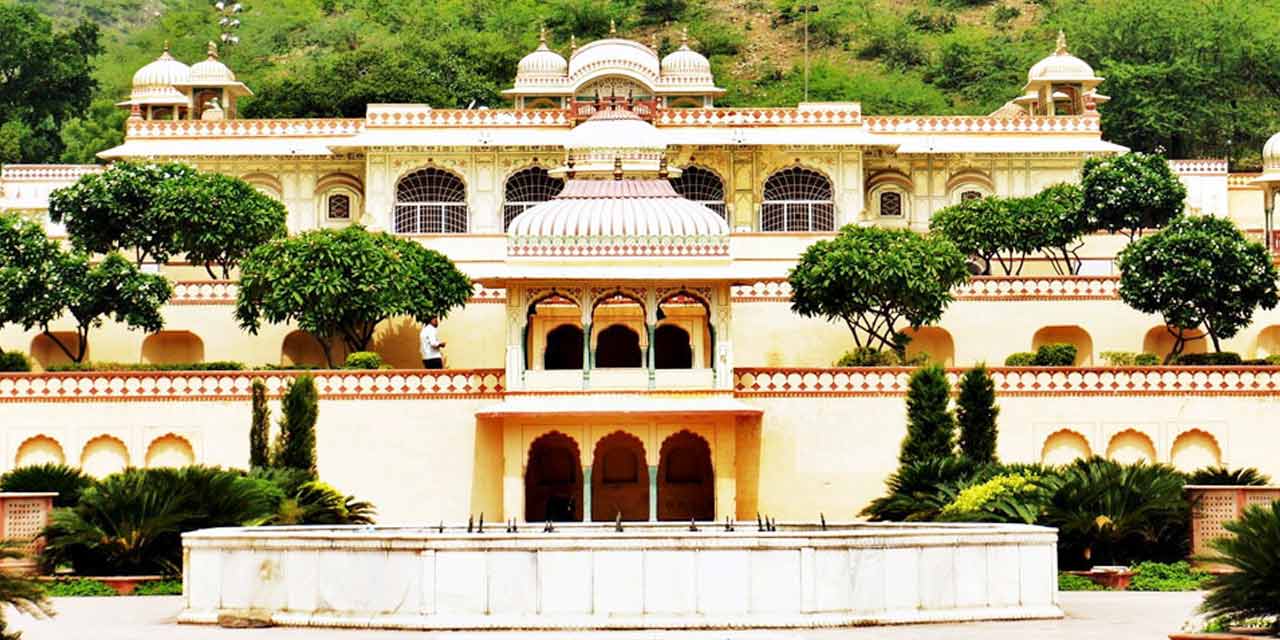
Built by Maharaja Sawai Jai Singh in 1728, Sisodia Rani ka Bagh is a garden dedicated to his beloved second wife, the Princess of Sisodia Rajput clan of Udaipur. Located around 10 kilometers away from Jaipur the lush gardens offer a rejuvenating respite from the bustle of the city.
The garden showcases elements of Indo-Mughal architecture such as water channels amidst beautiful flower beds and walking tracks across the parks. Fountains and natural springs add a splash of royalty to the garden and a shrine dedicated to Hindu deities’ augment spirituality to its ambiance. The walls of the garden are painted with several scenes from the story of Lord Krishna and Radha. You can spend a day amidst nature and rejuvenate in the tranquil setting of the park.
- Timings: 8:00 AM – 8:00 PM
- Entry Fee: ₹50 (Indians), ₹200 (Foreigners)
14. Vidyadhar Garden
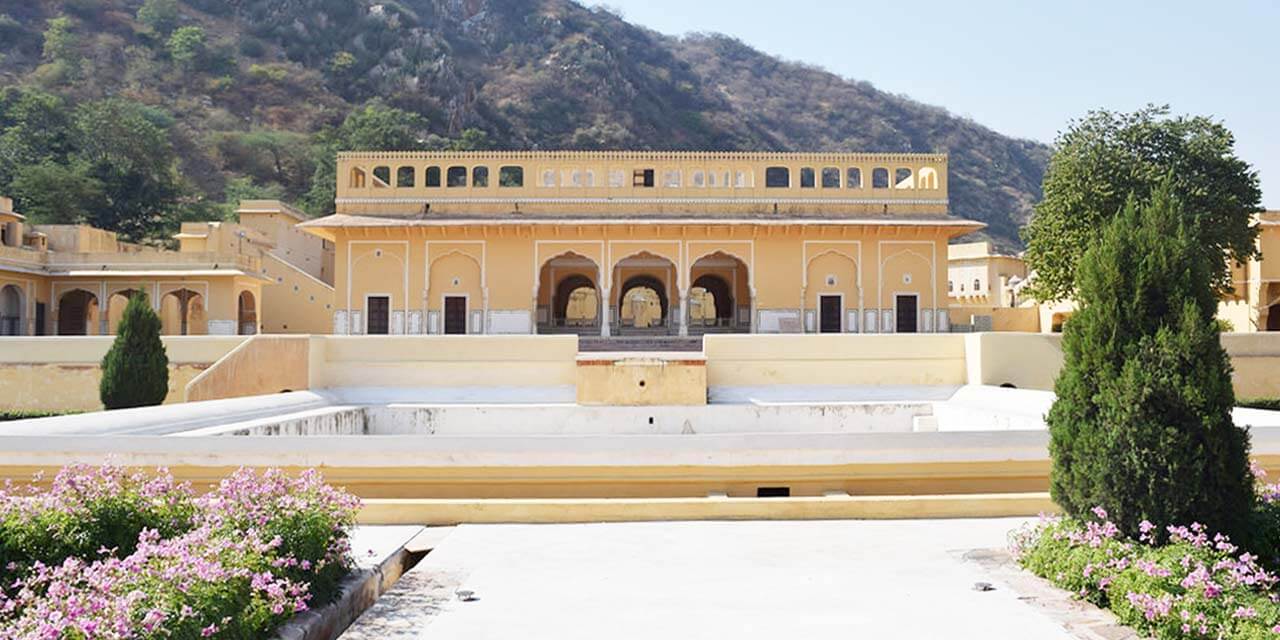
Dedicated to the chief architect of Jaipur, Vidyadhar Garden was built in 1988. Vidyadhar Bhattacharya was a treasured architect in Maharaja Sawai Jai Singh’s court. He was adept with the principles of Hindu architecture known as ‘Shilpa Shastra’.
Vidyadhar Garden is situated around 8 kilometers away from Jaipur on the Jaipur-Agra highway, away from the cacophony of the city, and is taken care of by the Rajasthan Government. The garden has a blend of classical Indian and Mughal architecture with glimpses of Hindu mythology depicted through murals on pavilion walls.
The lush gardens have beautiful flower beds, terraced lawns, and fountains influenced by Mughal designs, are a perfect picnic spot. You can spend time in the garden watching peacocks and other migratory birds while relaxing in the lap of nature. You can also enjoy elaborate Rajasthani meals or grab quick bites at the modern restaurant inside the complex.
- Timings: 8:00 AM – 5:00 PM, 6:00 PM – 8:00 PM
- Entry Fee: Free
15. Albert Hall Museum
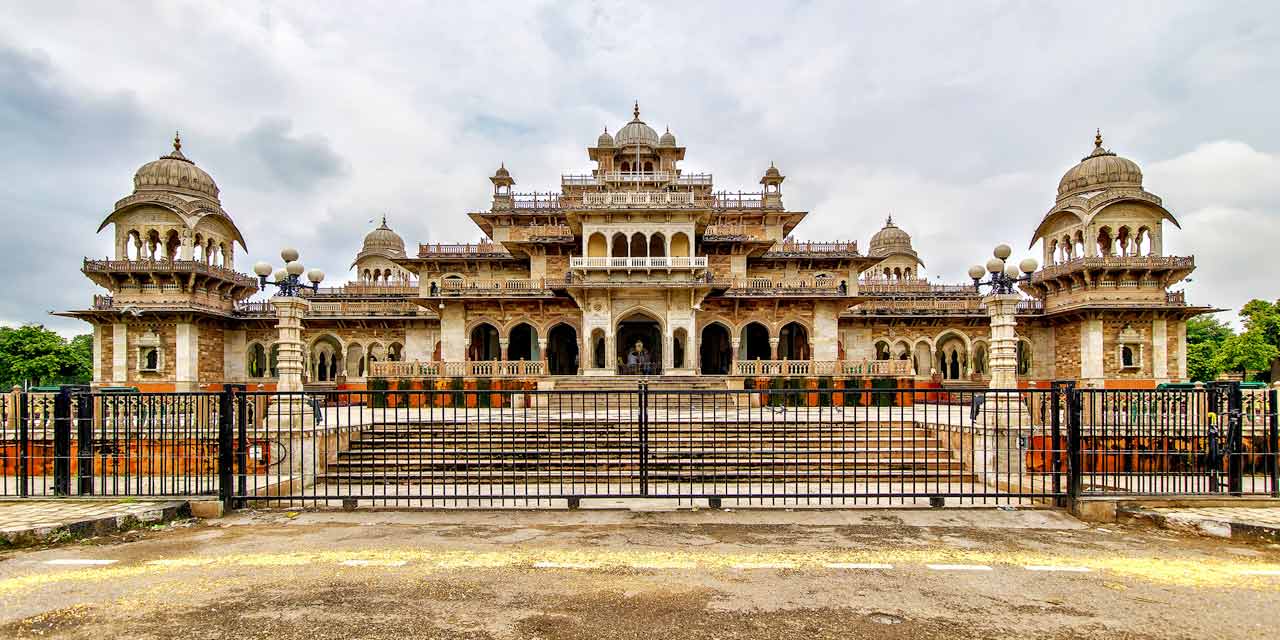
Jaipur’s historical journey and rich heritage can be best explored through its museums. Albert Hall Museum is among the most prominent museums in the city and is renowned for its well-blended architecture. It was built in 1876 as a concert hall and its design had a stark resemblance to the Victoria and Albert Museum of London.
The foundation was laid in 1876 by the Prince of Wales during his Jaipur visit and was converted into a museum by the King of Jaipur, Maharaja Sawai Madho Singh II in 1881. The charming Indo-Saracenic dome structure with intricately engraved arches is built in red sandstone.
You can explore the culture of Rajasthan through the 16 galleries of this museum. Paintings, portraits, carpets, musical instruments, jewelry, ammunition, woodwork, brassware, antique coins, local pottery, handicrafts, and sculptures are on display at the museum. Other attractions worth exploring at the complex are an aviary, a greenhouse, and a zoo.
- Timings: 9:00 AM – 9:00 PM
- Entry Fee: Starting from ₹50 (Indians), ₹300 (Foreigners)
16. Galtaji Temple
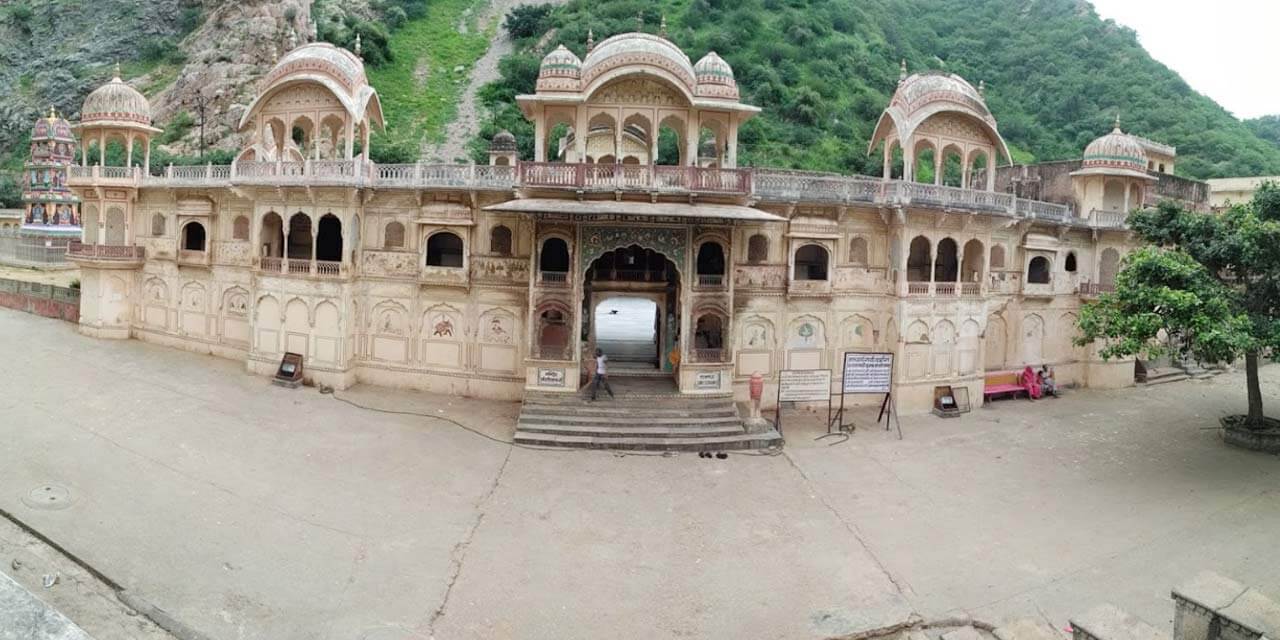
Galtaji Temple is a revered Hindu pilgrimage built by Diwan Rao Kriparam in the 18th century and was dedicated to Saint Galav. Constructed around 10 kilometers away from the city amidst the Aravalli hills in a mystical setup, the temple draws in travelers of all types.
There are several shrines of Hindu gods Lord Rama, Lord Krishna, and Lord Hanuman around the Galtaji Temple. Holy kunds, pavilions, and natural springs add charm to the majestic temple built in pink sandstone and designed as a palace.
Natural freshwater springs from the Aravalli hills supply water to seven holy 'kunds' or water tanks in the temple complex. The 'Galta Kund' is believed to be filled with water throughout the year and considered the holiest of all kunds. Pilgrims take a dip in the reverent water that flows from the 'Gaumukh', a rock shaped like a cow's head, and fills the tanks. The grandeur of the temple in the beautiful natural setting makes it a picture-perfect spot.
- Timings: 5:00 AM – 9:00 PM
- Entry Fee: Free
17. Swargsuli Tower
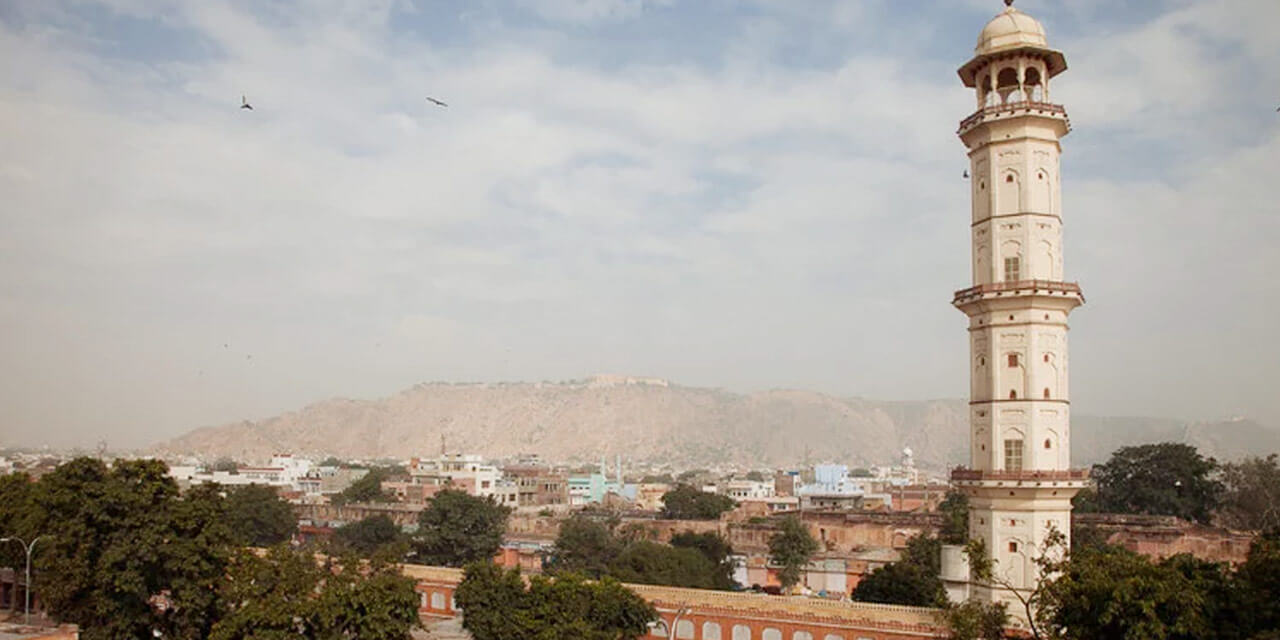
Swargsuli Tower or SargaSuli is the tallest tower of Jaipur, built in 1749 to commemorate the victory of Maharaja Sawai Ishwari Singh at the Battle of Rajmahal. Located at the Aatish market, the 140 feet tower was designed by the royal craftsman Ganesh Khowan drawing in elements from Delhi’s Qutub Minar and Chittorgarh’s Kirti Stambh.
The tower had a contrasting yellow color which made it stand out against the pink color across the city. The seven-storeyed minaret offers breathtaking panoramic views of Jaipur. You can climb up to the top floor through a flight of 264 steps and enjoy the enthralling view of Jaipur city.
- Timings: 9:00 AM – 5:00 PM
- Entry Fee: ₹50 per person
18. Jawahar Kala Kendra
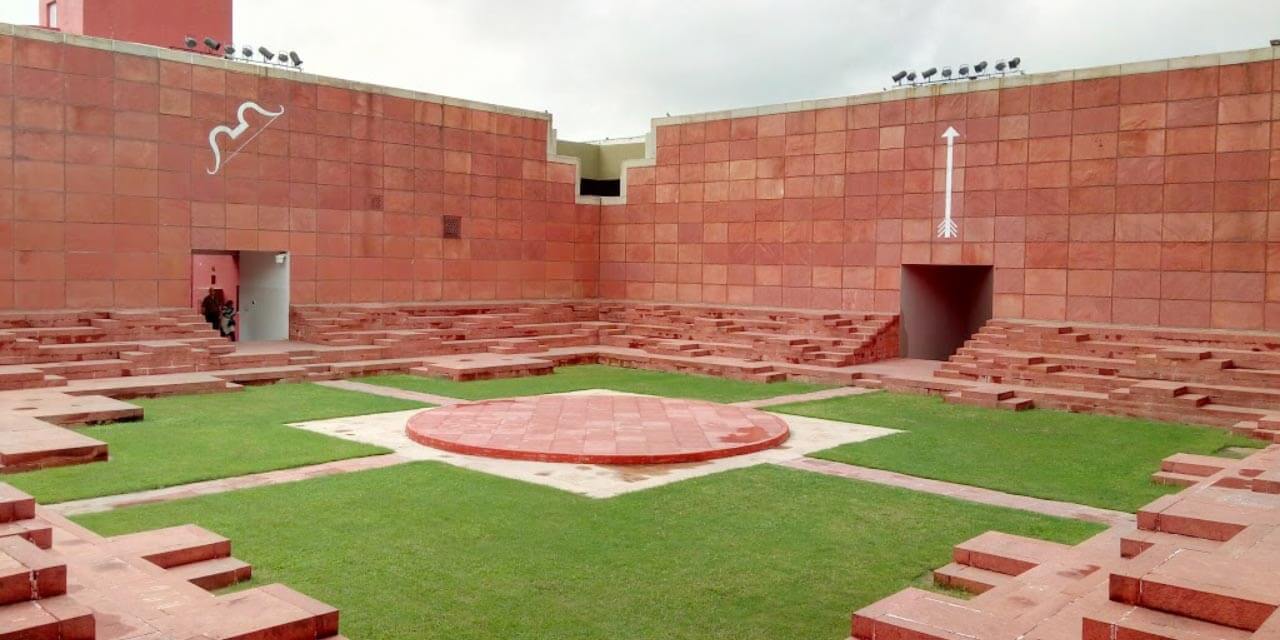
Jawahar Kala Kendra is an arts and crafts center built in the heart of Jaipur. Construction work was initiated in 1986 as per the layout designed by Charles Correa based on the Indian architectural concepts of Vaastu and Shilpa Shastra. Upon completion in 1991 the center was launched by the state government and dedicated to the first Prime Minister of India, Pandit Jawahar Lal Nehru.
Jawahar Kala Kendra preserves Rajasthani culture, traditions, and spiritual values. The red sandstone structure is dedicated to the late prime minister of India, Jawaharlal Nehru. You can visit the library, theatre, galleries, and auditoriums to explore the rich heritage of India.
- Timings: 10:00 AM – 9:00 PM
- Entry Fee: Free
19. Sheesh Mahal

Sheesh Mahal is located in the Amber Fort complex. It is popularly known as “The Palace of Mirrors” and has been alluring scores of tourists from across the world. Built by Maharaja Man Singh in 1727, the opulent palace has an intricate setting of precious stone and mirror work on its walls and ceilings.
The mirror arrangement is peculiar as it reflects a single ray of light to brighten up the entire room. You can witness the exquisite mirror work and marvel at the expertise of designers and architects in those times.
- Timings: 7:00 AM – 9:00 PM
- Entry Fee: ₹100 (Indians), ₹500 (Foreigners)
20. Anokhi Museum of Hand Printing
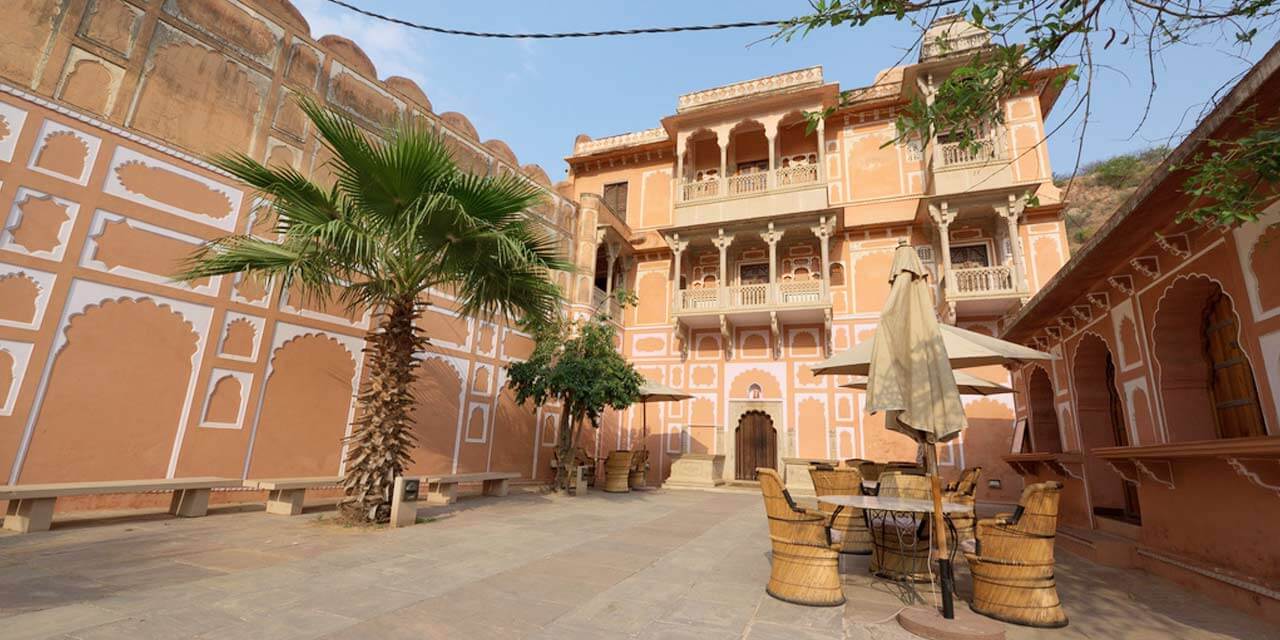
Dedicated to the traditional Rajasthani art of hand-block printing, Anokhi Museum of Hand Printing is a unique museum just a kilometer away from Amber Fort. It was started to preserve the age-old tradition of carving designs on wooden blocks and printing them on fabrics.
The charitable foundation operates from a 400-year-old two-story haveli known as Chanwar Palki Walon ki Haveli, which has been restored to perpetuate the craft of hand printing using natural dyes. The project has been awarded for ‘Cultural Heritage Conservation’ by UNESCO in 2000.
You can have a holistic experience of the old tradition and see the tools and techniques used to create the blocks and fabrics with contemporary designs. Block carving and hand printing workshops are also conducted by the management upon special request. You can buy handcrafted ‘Anokhi’ merchandise such as textiles, home furnishings, jewelry, and cards at the museum souvenir shop.
- Timings: 10:30 AM – 5:00 PM (Closed On Mondays)
- Entry Fee: ₹80 (Adult), ₹50 (Child)
21. Elefun
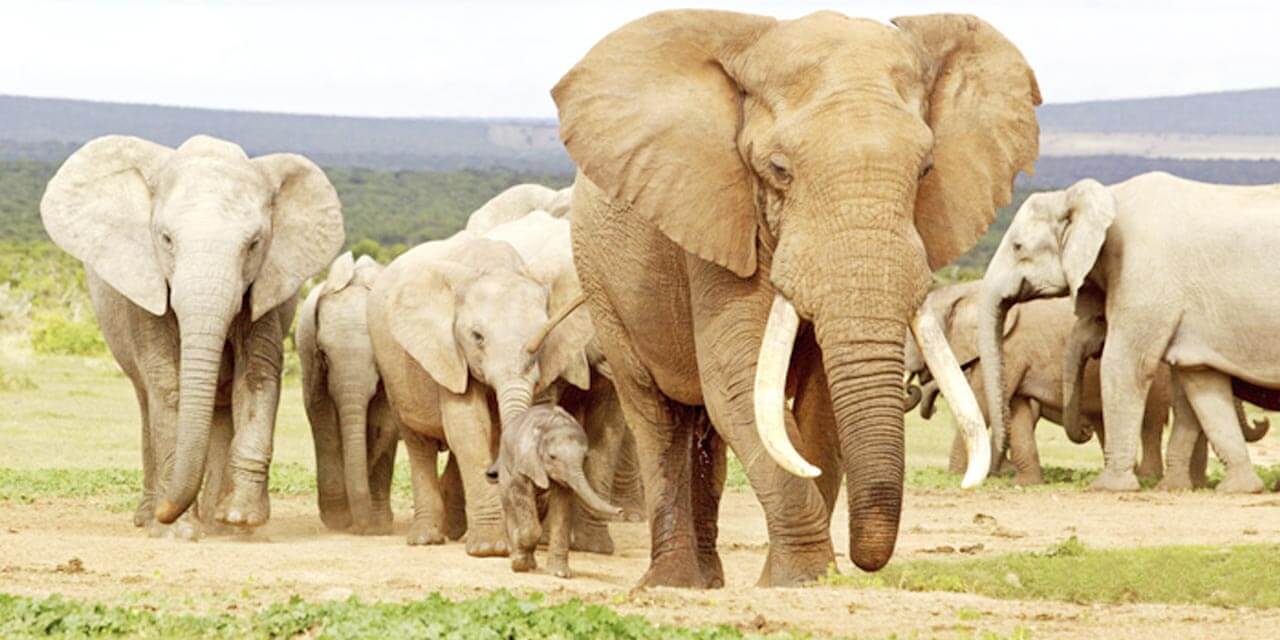
Elefun is an elephant sanctuary dedicated to preserving the species. Started in 2013, the place is run by a family of mahouts (elephant caretakers). The establishment offers natural living conditions to elephants and interesting animal interaction experiences to the visitors.
Some of the elephants at the sanctuary have been rescued from circuses and zoos to provide them with loving and natural living conditions. You can enjoy fun activities such as learning to talk to Elephants, walking with them, feeding, and bathing them. You can also decorate an elephant using natural colors and traditional patterns. Elefun is a great place to visit with family and kids.
- Timings: 8:00 AM – 6:00 PM
- Entry Fee: ₹4550 for the entire day
22. Khole Ke Hanuman Ji Temple
Constructed by Pandit Radhe Lal Choubey in 1960, Khole Ke Hanuman Ji Temple is a Hindu temple dedicated to Lord Hanuman. Located atop a hillock on the Delhi bypass in Jaipur at Lakshman Dungri, the temple offers panoramic views of the tranquil and green surroundings.
Khole Ke Hanuman Ji temple was built after Pt. Choubey spotted a rock with a carving of Lord Hanuman and started offering prayers at the spot. He built a small temple at the spot which was later expanded to its current size gradually. The shrine is highly revered by the locals and is flocked by devotees on Tuesdays and Saturdays. Dal-Bati Churma and Swamani Prashads are the traditional offerings that are prepared using raw ingredients donated by the devotees.
- Timings: 5:00 AM – 11:00 PM
- Entry Fee: Free
23. Maharaja Sawai Man Singh II Museum
In 1959 Maharaja Sawai Man Singh II converted a part of the City Palace constructed by Maharaja Sawai Jai Singh II into a museum known as the City Palace Museum. Later, several other sections of the palace were added to the museum, and it came to be known as Maharaja Sawai Man Singh II Museum.
It has five gallery sections- Textile gallery, Sarvatobhadra, Sabha Niwas, Sileh Khana, and the Painting & Photography gallery. Royal costumes, artifacts, and furnishings from the last three centuries are on display at the Museum. A walk through the galleries of the museum will satiate your curiosity about the regal life of the rulers of Jaipur and the rich heritage of Rajputana.
The exhibits also include traditional paintings and portraits of the royal family. The arms and armor collection of the warrior clan includes arrows, axes, shields, spears, daggers, and guns. You can buy souvenirs at the museum shop called the Palace Atelier and taste royal delicacies at the Baradari restaurant at the City Palace Complex.
- Timings: 9:30 AM – 5:00 PM
- Entry Fee: ₹130 (Indians), ₹400 (Foreigners)
24. Johari Bazaar
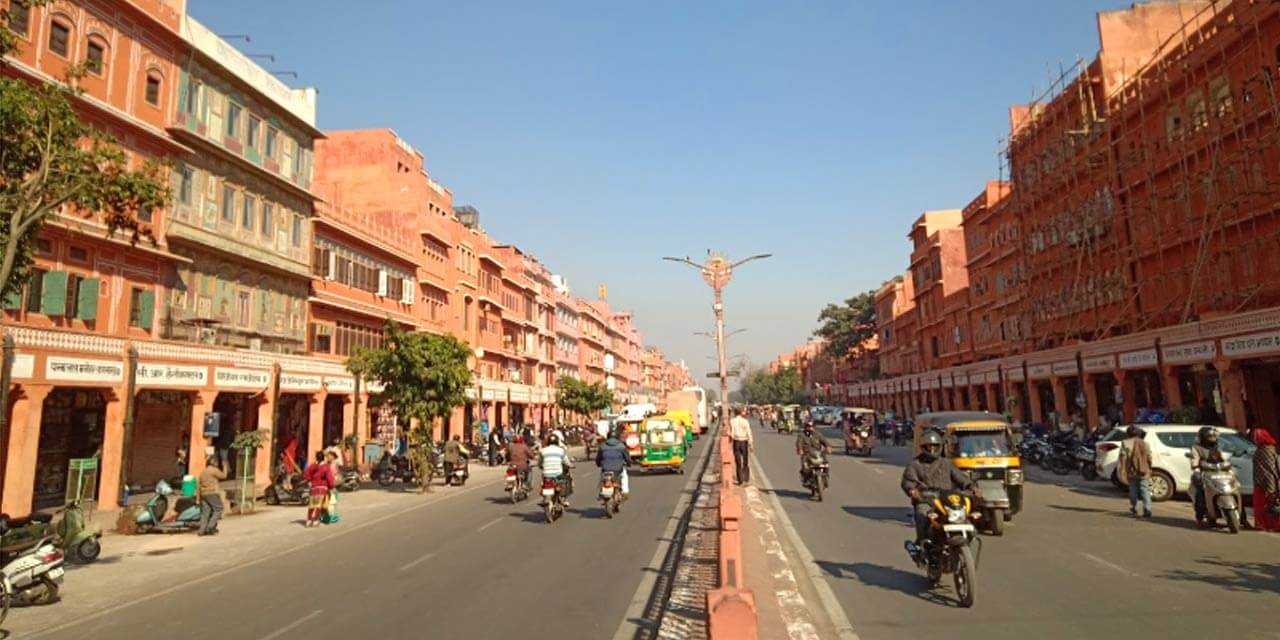
Jaipur is the business hub of Rajasthan, famous for its handicrafts and indigenous products. Johari Bazaar is the oldest and most colorful market in Jaipur, located near Hawa Mahal. It is a shopper’s paradise offering vibrant handmade products, scrumptious local food, and premium quality Kundan jewelry.
You can buy authentic Jaipuri jewelry made in gold, silver studded with diamonds, emeralds, and rubies. The narrow lanes of the market are loaded with colorful traditional apparel, embroidered juttis, and opalescent lehengas.
The small stalls sell everything including famous Jaipuri textiles, traditional blue pottery, cotton quilts, and home décor products. Make sure to bargain well as prices are often swelled up for tourists.
- Timings: 10:00 AM – 11:00 PM
- Entry Fee: Free
25. Bapu Bazaar
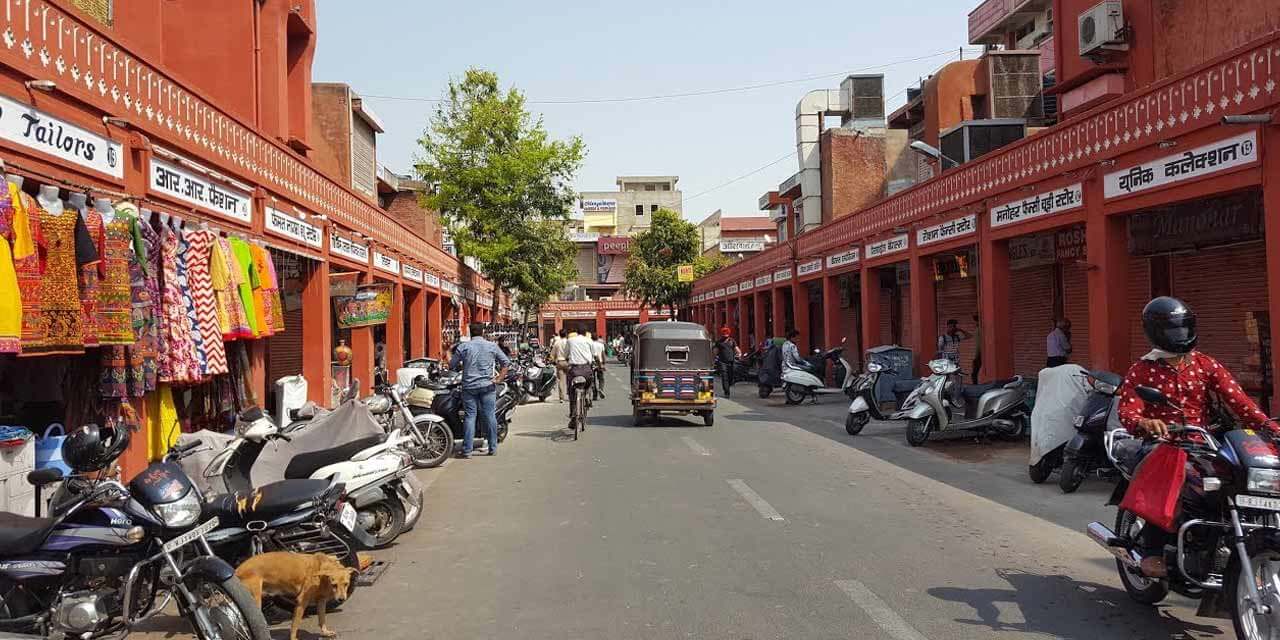
Bapu Bazaar is located between the Sanganer Gate and the New Gate of Jaipur. It is one of the most famous markets in Pink city and the best place to buy anything Rajasthani. The exuberant market attracts shoppers from all over the world.
You can buy authentic mojari footwear made of camel hide, lac bangles, bandhani dupattas, leheriya sarees, potli bags, colorful puppets, ethnic jewelry, fine cotton quilts, and handwoven textiles at reasonable prices. You can also pick up beautiful showpieces, artifacts, baubles, pen stands, keychains with mirror work as souvenirs and gifts for your loved ones.
Don’t forget to binge on local snacks and authentic dishes such as chat, samosas, dal-baati-churma, masala tea, and pyaaz kachori. Falooda kulfi is a must-have specialty at Bapu bazaar, it is yummy and keeps you cool as you shop.
- Timings: 10:30 AM – 7:30 PM
- Entry Fee: Free
